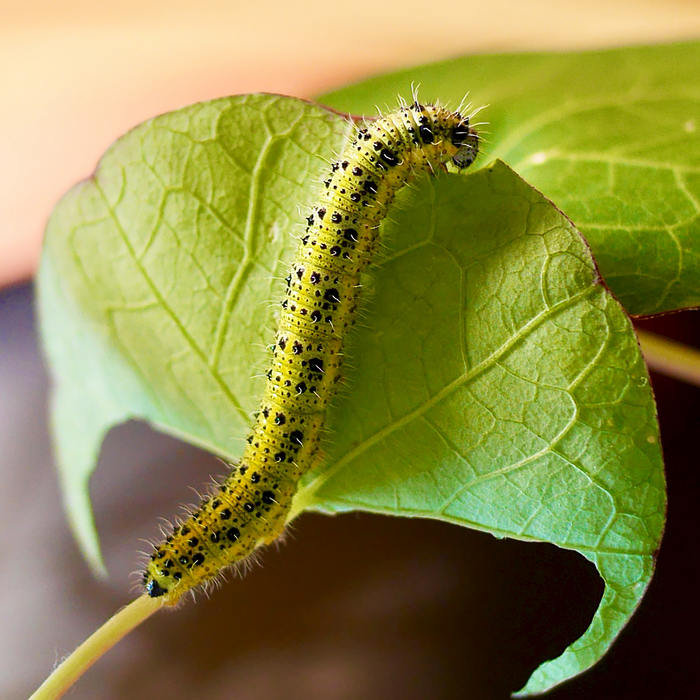Cruciferous plants, such as cabbage, rapeseed, horseradish or mustard, have a special defense strategy against herbivores called the “mustard oil bomb”. They store glucosinolates as defensive substances that react with myrosinase enzymes when caterpillars feed, i.e., when plant tissue is damaged. The myrosinases cleave the glucosinolates and as a result, toxic mustard oils are produced. The pungent taste of mustard and horseradish is the result of the mustard oil bomb.

Credit: Yu Okamura
Cruciferous plants, such as cabbage, rapeseed, horseradish or mustard, have a special defense strategy against herbivores called the “mustard oil bomb”. They store glucosinolates as defensive substances that react with myrosinase enzymes when caterpillars feed, i.e., when plant tissue is damaged. The myrosinases cleave the glucosinolates and as a result, toxic mustard oils are produced. The pungent taste of mustard and horseradish is the result of the mustard oil bomb.
Researchers led by Yu Okamura and Heiko Vogel of the Max Planck Institute for Chemical Ecology in Jena, Germany, have now studied in more detail the deactivation of the mustard oil bomb by the cabbage white butterfly, an important pest on cabbage plants. Earlier work identified two caterpillar enzymes that play a central role in detoxification, and the genes that encode them: the NSP enzyme (nitrile specifier protein), which manipulates the potential mustard oil bomb to produce non-toxic nitriles instead of toxic mustard oils, and the MA enzyme (major allergen), which was hypothesized to also be important for the survival of cabbage whitefly caterpillars on cruciferous plants. The NSP and MA genes are sister genes and each evolved from a gut protein of unknown function found in many butterfly species. Both enzymes are found exclusively in cabbage white butterflies and other species of the Pieridae (white butterfly) family whose host plants contain glucosinolates. “We wondered whether both enzymes are important for the detoxification of glucosinolates and insect fitness. After all, previous studies have shown that related butterfly species that no longer feed on plants containing glucosinolates have lost the enzymes during evolution. This indicates that it is apparently costly for insects to maintain enzyme activity in the absence of these plant defenses. We also wanted to know whether the function of the two enzymes differs depending on the composition of the glucosinolates in different cruciferous plants,” Heiko Vogel summarizes the initial questions of the study.
Crucial for testing the function of the NSP and MA genes was the genome editing technique CRISPR-Cas9, which enabled the researchers to use caterpillars lacking either the NSP gene, the MA gene, or both, in their experiments. These caterpillars thus also lacked the appropriate enzymes for detoxifying glucosinolates. Subsequently, plants with different levels of glucosinolates were used in feeding assays to check how caterpillars developed. Caterpillars lacking only one of the two enzymes were still able to survive on plants with high concentrations of the defense substances, even though their growth was restricted. However, caterpillars in which both genes had been knocked out were no longer able to grow and survive on their natural host plants. “These results came as a surprise because especially the role of the MA enzyme in the interaction between cabbage white butterflies and host plants was previously unclear,” said first author Yu Okamura.
Thus, for cabbage white butterfly caterpillars, both enzymes, NSP and MA, are important to disarm the mustard oil bomb of their host plants. Because NSP and MA differ in their detoxification capacity toward different glucosinolates, caterpillars can fine-tune the activation of the NSP and MA genes depending on the glucosinolate profile of their host plants. When caterpillars lack one of the enzymes, they grow more slowly, but the degree of growth restriction depends on the glucosinolates present in the host plants. “Using a panoply of detection, regulatory and detoxification mechanisms, cabbage white butterflies accurately tailor how they defuse different mustard oil bombs from the spectrum of their host plants, displaying a sensitivity to both plant glucosinolate profiles and to their activation,” says Heiko Vogel.
By using genome-editing techniques, the study shows that both NSP and MA enable cabbage white butterfly caterpillars to respond highly flexibly to mustard oil bombs, which is critical in enabling the insects to adapt to a broader range of cruciferous plants. “We believe our work emphasizes the importance of the emergence of such genes for herbivorous insects in the arms race with the chemical defenses of their host plants. The competition between insects and their host plants involves more than the mere presence of chemical defenses and detoxification mechanisms. The regulation and activation of detoxification enzymes also represent key components of complex interactions and explain the evolutionary success of these pest insects,” Yu Okamura summarizes.
Journal
Proceedings of the National Academy of Sciences
DOI
10.1073/pnas.2208447119
Method of Research
Experimental study
Subject of Research
Animals
Article Title
Testing hypotheses of a coevolutionary key innovation reveals a complex suite of traits involved in defusing the mustard oil bomb
Article Publication Date
12-Dec-2022




